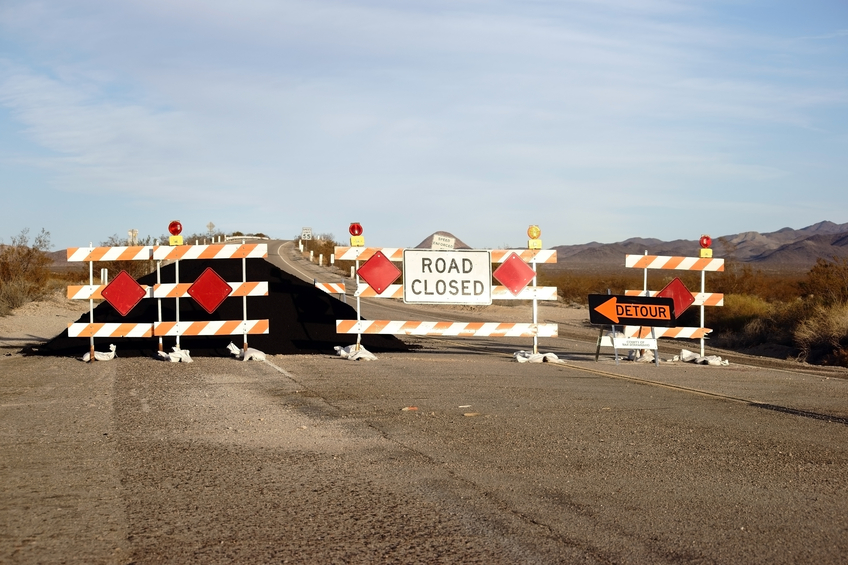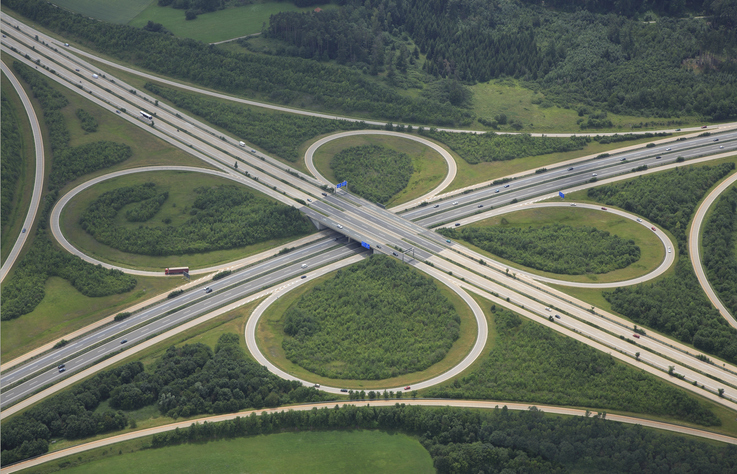North Dakota Transportation and Ethics 30 PDH Discount Package 1
Signal Timing Optimization (C05-005)
Traffic Bottlenecks Operational Improvements (C06-018)
Traffic Control Concepts for Urban and Suburban Streets (C07-004)
Transportation Management Plans for Work Zones (C07-001)
Ethics, Professionalism and Disciplinary Actions: Case Studies (LE1-003)

This online engineering PDH course presents the fundamental design principles common among all roundabout types. This course also presents detailed design considerations specific to multilane roundabouts, rural roundabouts, and mini-roundabouts.
Designing the geometry of a roundabout involves choosing between trade-offs of safety and capacity. Roundabouts operate most safely when their geometry forces traffic to enter and circulate at slow speeds. Horizontal curvature and narrow pavement widths are used to produce this reduced-speed environment. Conversely, the capacity of roundabouts is negatively affected by these low-speed design elements. As the widths and radii of entry and circulatory roadways are reduced, the capacity of the roundabout is also reduced.
Furthermore, many of the geometric parameters are governed by the maneuvering requirements of the largest vehicles expected to travel through the intersection. Thus, designing a roundabout is a process of determining the optimal balance between safety provisions, operational performance, and large vehicle accommodation.
This 4 PDH online course is applicable to traffic engineers, transportation planners, managers, and other technical professionals who are involved in the geometric design of roundabouts.
This PE continuing education course is intended to provide you with the following specific knowledge and skills:
- Familiarizing with the different types of roundabouts
- Understanding the geometric elements
- Learning the general design principles
- Selecting the appropriate inscribed circle diameter
- Designing the alignment of approaches
- Designing entry and exit curves
- Designing the central and splitter islands
- Determining the stopping and intersection sight distances
- Designing methods to avoid vehicle path overlap
In this professional engineering CEU course, you need to review Chapter 6, "Geometric Design", of the Federal Highway Administration Publication FHWA-RD-00-067, "Understanding Roundabouts".
Upon successful completion of the quiz, print your Certificate of Completion instantly. (Note: if you are paying by check or money order, you will be able to print it after we receive your payment.) For your convenience, we will also email it to you. Please note that you can log in to your account at any time to access and print your Certificate of Completion.

This online engineering PDH course examines various cost-effective techniques that can be used to generate good signal timing plans that can be employed when there are insufficient financial resources to generate the plans using conventional techniques. This course develops a "tool box" of procedures and provides examples of how the tool box can be used when there is a moderate signal timing budget, when there is a modest signal timing budget, and when there is a minimum signal timing budget.
The conventional approach to signal timing optimization and field deployment requires current traffic flow data, experience with optimization models, familiarity with the signal controller hardware, and knowledge of field operations including signal timing fine-tuning. Developing new signal timing parameters for efficient traffic flow is a time-consuming and expensive undertaking.
This 5 PDH online course is applicable to traffic engineers and planners, administrators, managers, and technicians who are trying to maintain the best possible signal timing settings and adjustments to meet the ever-increasing traffic demands with less than optimal budgets.
This PE continuing education course is intended to provide you with the following specific knowledge and skills:
- Identifying system intersections
- Collecting and organizing existing data
- Conducting a site survey
- Obtaining turning movement data
- Calculating local timing parameters
- Identifying signal groupings
- Calculating coordination parameters
- Installing and evaluating new plans
In this professional engineering CEU course, you need to review the Federal Highway Administration Publication FHWA-HOP-07-006, "Signal Timing on a Shoestring".
Upon successful completion of the quiz, print your Certificate of Completion instantly. (Note: if you are paying by check or money order, you will be able to print it after we receive your payment.) For your convenience, we will also email it to you. Please note that you can log in to your account at any time to access and print your Certificate of Completion.

This online engineering PDH course describes bottlenecks and explores near-term operational and low-cost construction opportunities to correct them.
Delays due to traffic congestion seem like an unavoidable, frustrating fact of life. Or are they—unavoidable, that is? This course focuses on traffic congestion caused by bottlenecks—which are specific locations on the highway system where the physical layout of the roadway routinely cannot process the traffic that wants to use it and results in localized, recurring congestion.
By focusing on relieving localized, recurring congestion at bottlenecks, this primer can help agencies identify the right fix for a particular bottleneck. What’s more, the right fix for a localized, recurring bottleneck is usually spot-specific, more effective, less expensive, and faster to implement than building a new facility.
This 6 PDH online course is applicable to traffic engineers and planners, conceptual and detail designers, and other technical professionals who are interested in gaining a better understanding in traffic bottlenecks operational improvements.
This PE continuing education course is intended to provide you with the following specific knowledge and skills:
- Understanding bottlenecks and congestion
- Learning about the different strategies of resolving congestion
- Knowing how to structure a localized bottleneck program
- Identifying, assessing and addressing bottlenecks
- Incorporating quick-fix bottleneck solutions into the Congestion Initiative
- Understanding how agencies are dealing with bottlenecks (case studies)
Upon successful completion of the quiz, print your Certificate of Completion instantly. (Note: if you are paying by check or money order, you will be able to print it after we receive your payment.) For your convenience, we will also email it to you. Please note that you can log in to your account at any time to access and print your Certificate of Completion.

This online engineering PDH course discusses traffic control concepts for urban and suburban streets. In planning and designing a traffic signal control system, one must first understand the applicable operational concepts related to signalized intersection control and signal-related special control. A number of commonly used proprietary traffic systems and simulations are discussed in this chapter. These discussions provide illustrations of the technology.
This 7 PDH online course is applicable to transportation planners, traffic engineers, agency personnel as well as design and construction personnel involved with the development, review, approval, implementation, and assessment of traffic control planning, designs and implementation.
This PE continuing education course is intended to provide you with the following specific knowledge and skills:
- Understanding the various control variables
- Learning the sampling, filtering and smoothing techniques
- Knowledge of traffic signal timing parameters and signal phasing
- Dealing with isolated intersections
- Understanding arterial and network control and other special controls
- Understanding the benefits and measures of effectiveness
In this professional engineering CEU course, you need to review Chapter 3, "Traffic Control Concepts - Urban and Suburban Streets" of the Federal Highway Administration Publication, FHWA-HOP-06-006, "Traffic Control Systems Handbook".
Upon successful completion of the quiz, print your Certificate of Completion instantly. (Note: if you are paying by check or money order, you will be able to print it after we receive your payment.) For your convenience, we will also email it to you. Please note that you can log in to your account at any time to access and print your Certificate of Completion.

This online engineering PDH course sets forth some basic guiding principles and describes a general approach for developing, implementing, and assessing TMPs. This course is a compendium of guidance material, available resources, and suggested practices to help develop, implement, and assess transportation management plans (TMP) for work zones.
Work zone objectives, needs, and issues vary from project to project. Therefore, it is ultimately up to the professional to establish procedures and implement TMPs that best serve the safety and mobility needs of the traveling public, highway workers, businesses, and community.
This 7 PDH online course is applicable to transportation planners, traffic engineers, agency personnel as well as design and construction personnel involved with the development, review, approval, implementation, and assessment of TMPs.
This PE continuing education course is intended to provide you with the following specific knowledge and skills:
- Understanding the purpose of transportation management plans
- Learning the process for TMP development, implementation and assessment
- Knowledge of potential TMP components
- Implementing work zone impacts management strategies
- Familiarizing with current TMP use, examples and practices
In this professional engineering CEU course, you need to review the Federal Highway Administration Publication FHWA-HOP-05-066, "Developing and Implementing Transportation Plans for Work Zones".
Upon successful completion of the quiz, print your Certificate of Completion instantly. (Note: if you are paying by check or money order, you will be able to print it after we receive your payment.) For your convenience, we will also email it to you. Please note that you can log in to your account at any time to access and print your Certificate of Completion.

In this online engineering PDH course, ten case studies of actual enforcement actions taken by a state licensing board are presented. The cases have been selected to be representative of situations likely to exist in many states. Board procedures and the types of enforcement actions available are shown by a variety of cases ranging from a geotechnical engineer who produced (within one hour and without visiting the site) a soils report, to an engineer who was unable to document his PDH's during a board audit. The importance of being very careful about when to put "P.E." after one's name on a document also will become apparent.
Codes of ethics for engineers typically describe standards for professional behavior. The enforcement of those ethical standards that are inscribed into law lies with the licensing boards of state governments.
This 1 PDH online course is intended primarily for all engineers seeking to deepen their understanding of what constitutes ethical and professional engineering behavior and how such behavior is enforced by the licensing board.
This PE continuing education course is intended to provide you with the following specific knowledge and skills:
-
Familiarizing with the format of enforcement decrees issued by a state licensing board
-
Knowing the ten different types of licensing violations
-
Understanding the investigative process of the board, as it attempts to determine the validity of complaints brought before it
-
Learning about the types of enforcement actions available to the board
In this professional engineering CEU course, you need to review the course document titled, "Ethics, Professionalism and Disciplinary Actions: Case Studies".
Upon successful completion of the quiz, print your Certificate of Completion instantly. (Note: if you are paying by check or money order, you will be able to print it after we receive your payment.) For your convenience, we will also email it to you. Please note that you can log in to your account at any time to access and print your Certificate of Completion.